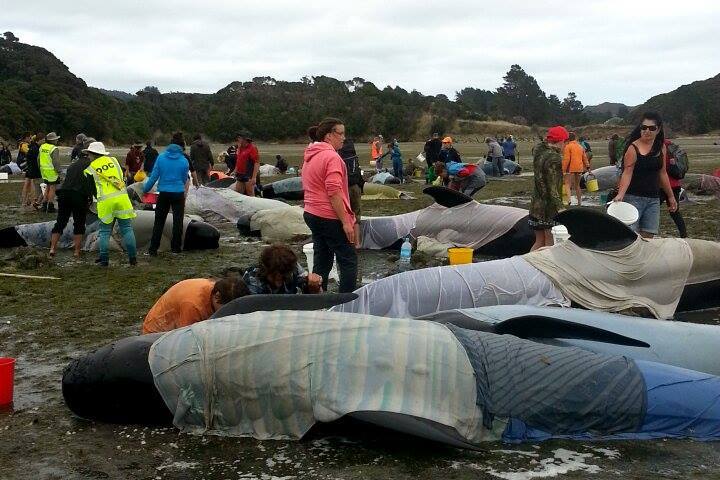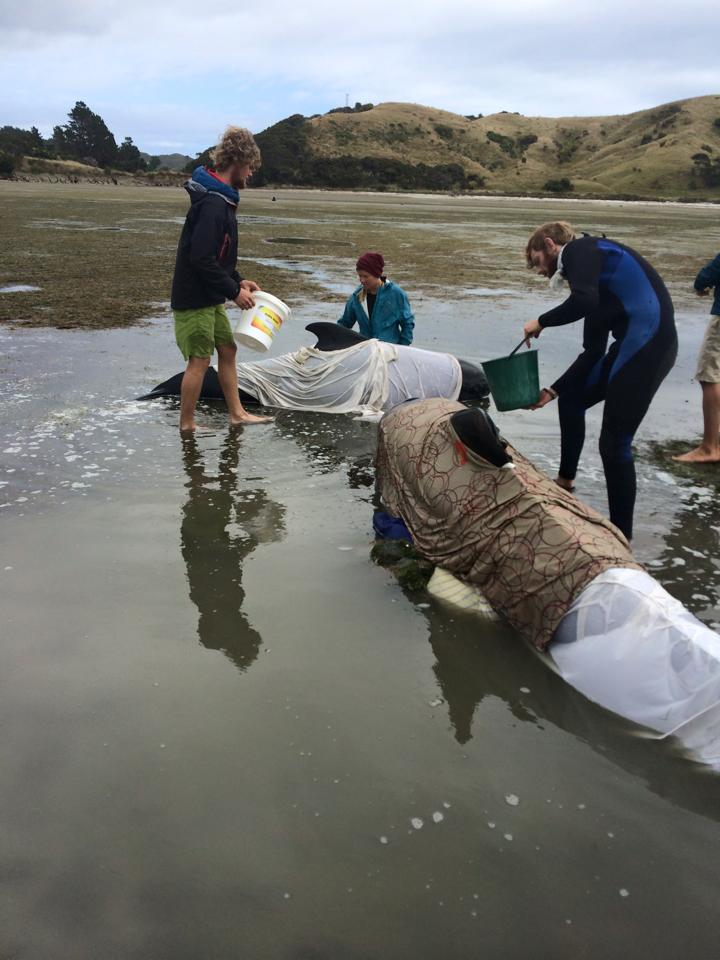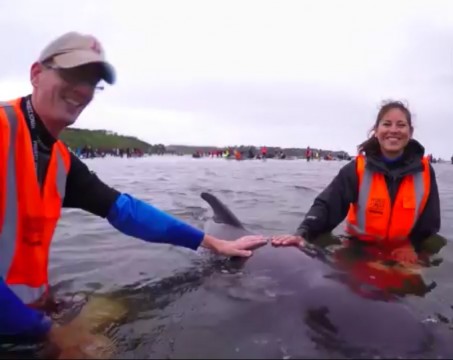Saving the Whales
Sixty of the 198 pilot whales that beached themselves in Golden Bay over the weekend have made it to safe water. Over 300 volunteers came from around the country to help stabilize the whales and keep them alive until high tide when they were re-floated.
One of those volunteers was Forest & Bird’s fundraiser, Adria Lopez Mackay. I asked her about the experience, what motivated her to train as a Marine Mammal Medic and the rewards of contributing to conservation as a volunteer.
When did you first hear about the stranding?
I saw it on Facebook on the Friday, but it wasn’t until 9pm that night when I got a text message from Project Jonah. They were putting out a call for trained Marine Mammal Medics to get down to Farewell Spit if they could.
What is a Marine Mammal Medic?
Project Jonah run a one day training course where they go through everything you might need to help whales or dolphins survive during a stranding. They go through the anatomy of marine mammals, the ones you will see in New Zealand, and what happens to them during a stranding. They talk about the reasons they may happen and how we can support them when it does. Part of it’s in the classroom, but then you go out to the beach and practice first aid on a blow up whale.
Was this your first time working on a stranding?
Yes – I did my training in November in 2013 and they told us that Farewell Spit was the most likely place we would be called to. This is the first time I received a call out text and I guess that’s because of the size of the stranding – there were so many whales. Usually, they might get all the help they need from Nelson and Blenheim medics.

Photo: Project Jonah New Zealand
How did you react?
Well, it was good timing! It was Friday night and I knew I had nothing on during the weekend, so it was just a matter of getting things together and finding transport. The InterIsland provides free transport for Project Jonah Marine Mammal Medics and you generally connect with other volunteers on Facebook to get rides from there. We went down and caught the 2.30am ferry then shared a van with a couple who had a few extra seats.
What was your first impression upon arrival?

Volunteers work to keep the whales cool and calm (Photo: Adria Lopez Mackay)
It was pretty heart breaking and I felt a bit helpless at first, but then the adrenaline kicked in and it was all go. We were straight into it. A lot of people had been there all morning – since the whales first re-stranded at 5am.
It was the first time I had seen whales not doing what they’re supposed to do – being helpless, and not healthy. Some of them had some pretty horrific wounds.
The entire pod had originally stranded on the Friday. They were re-floated, but it was quite hot on Friday and there weren’t enough people to help them. They were badly blistered and some of them had open wounds. But luckily, on the Saturday that they re-stranded, the weather was overcast and so the wounds didn’t get any worse.
What was the general feeling among the group? Was there hope?
Yeah – everyone was supportive and working together really well to make sure these whales got the best care. Everyone was just so focused on ensuring they were cool and calm. And looking forward to the possibility of re-floating them, which started at high tide about 4.30pm.
What was the process of re-floating like?
Well, we move everything around them away and take off the sheets they’ve spend the day covered in. We continued to keep them cool and calm and waited for the water to come in. I was working on quite a young whale and ours was one of the first to start to swim – just because it was so small. But for some of the bigger whales, high tide didn’t mean much, and they literally had to be pushed through the sand into deeper water.
Once you let go of a whale you join hands and create a chain along the shoreline to prevent the whales trying to come back in and re-stranding.
What was the biggest challenge of the weekend?
For me, it was just the emotional aspect of it. There’s no certainty that they would survive until the next morning when we could be sure they hadn’t re-stranded.
Did you form a bond with the whales you were working on?
For most of it, I was working on a juvenile whale. When I arrived, there were two young girls who had been looking after “her” for hours and they had named her – Lily. So I had to let them know I was going to do everything I could to get this whale swimming again.
It’s hard not to form a bond with them – part of keeping them calm is just speaking to them and counting their breaths to make sure they’re not stressed out. They don’t really open their eyes, but if you speak to them they’ll sometimes open one and look at you. It was really powerful.
In the end, I was exhausted. But waking up on the Sunday to hear that they hadn’t been seen again was a great feeling.

With “Lily” at high tide.
